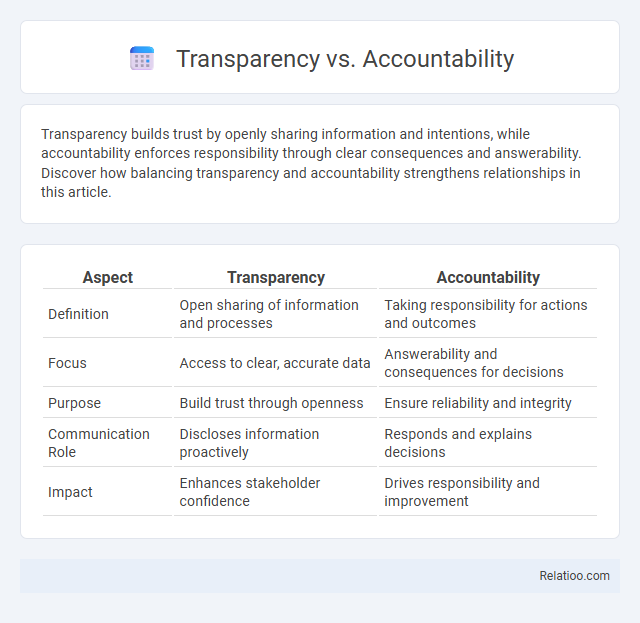Transparency builds trust by openly sharing information and intentions, while accountability enforces responsibility through clear consequences and answerability. Discover how balancing transparency and accountability strengthens relationships in this article.
Table of Comparison
| Aspect | Transparency | Accountability |
|---|---|---|
| Definition | Open sharing of information and processes | Taking responsibility for actions and outcomes |
| Focus | Access to clear, accurate data | Answerability and consequences for decisions |
| Purpose | Build trust through openness | Ensure reliability and integrity |
| Communication Role | Discloses information proactively | Responds and explains decisions |
| Impact | Enhances stakeholder confidence | Drives responsibility and improvement |
Understanding Transparency: Definition and Importance
Transparency entails openly sharing accurate, timely information to foster trust and enable informed decision-making. It is crucial for organizations and governments to provide visibility into their operations, policies, and performance to promote credibility and public confidence. Understanding transparency enhances stakeholder engagement by ensuring access to clear, accessible data that supports ethical practices and compliance.
Defining Accountability in Modern Contexts
Accountability in modern contexts refers to the obligation of individuals and organizations to take responsibility for their actions, decisions, and policies, ensuring answerability and consequences for outcomes. Transparency involves openly sharing information and processes to enable scrutiny, while accountability emphasizes the enforcement of standards and rectification of failures. Your understanding of accountability is crucial for fostering trust and integrity within institutions and society by linking transparency with responsibility and action.
Key Differences Between Transparency and Accountability
Transparency involves openly sharing information and processes, allowing stakeholders to see how decisions are made and resources are utilized. Accountability requires taking responsibility for actions and outcomes, ensuring individuals or organizations answer for their performance and correct any mistakes. Your organization benefits when transparency builds trust while accountability drives ethical behavior and effective governance.
How Transparency Drives Organizational Trust
Transparency enhances organizational trust by openly sharing information, decisions, and processes with stakeholders, fostering a culture of honesty and openness. Clear communication and access to relevant data empower employees and clients to feel confident in the organization's integrity and intentions. This openness reduces suspicion, promotes accountability, and strengthens long-term relationships based on mutual respect and reliability.
The Role of Accountability in Effective Governance
Accountability is a cornerstone of effective governance, ensuring that public officials and institutions are answerable for their actions, decisions, and policies. It reinforces transparency by creating mechanisms for monitoring, evaluation, and consequences, which help maintain public trust and deter corruption. Strong accountability frameworks support ethical governance, improve service delivery, and enhance the overall legitimacy of political systems.
Interdependence of Transparency and Accountability
Transparency and accountability are interdependent concepts essential for effective governance and organizational integrity. Transparency ensures accessible, clear information, enabling stakeholders to evaluate actions, while accountability requires entities to justify their decisions and face consequences. This reciprocal relationship fosters trust, promotes ethical behavior, and enhances public confidence in institutions.
Common Misconceptions: Transparency vs Accountability
Common misconceptions often conflate transparency with accountability, but transparency refers to the openness and accessibility of information, whereas accountability involves being held responsible for actions and decisions. Transparency enables stakeholders to monitor processes and outcomes, but without proper mechanisms for accountability, transparency alone cannot ensure responsible governance or ethical behavior. Effective organizational performance requires both transparent information sharing and enforceable accountability measures.
Case Studies: Success Through Transparency and Accountability
Case studies demonstrate that organizations embracing transparency and accountability achieve higher trust, improved performance, and stakeholder engagement. For example, Patagonia's open supply chain information and Tesla's quarterly updates illustrate how transparent practices foster accountability and strengthen brand reputation. These cases highlight that sustained success arises from measurable transparency combined with clear accountability frameworks.
Challenges in Balancing Transparency and Accountability
Balancing transparency and accountability presents challenges such as maintaining data privacy while ensuring open access to information, which often leads to conflicts between organizational disclosure and protecting sensitive details. Organizations struggle to implement transparent processes without compromising accountability mechanisms, as excessive openness can hinder decision-making efficiency and expose vulnerabilities. Effective governance requires navigating these tensions to achieve a coherent strategy that promotes trust while safeguarding operational integrity.
Strategies to Enhance Both Transparency and Accountability
Implementing clear communication channels and open data platforms significantly enhances transparency by providing stakeholders with accessible and timely information. Establishing robust audit systems and performance metrics promotes accountability through regular monitoring and evaluation of organizational actions. Integrating participatory decision-making processes ensures both transparency and accountability by involving stakeholders in governance and fostering trust.

Infographic: Transparency vs Accountability
 relatioo.com
relatioo.com